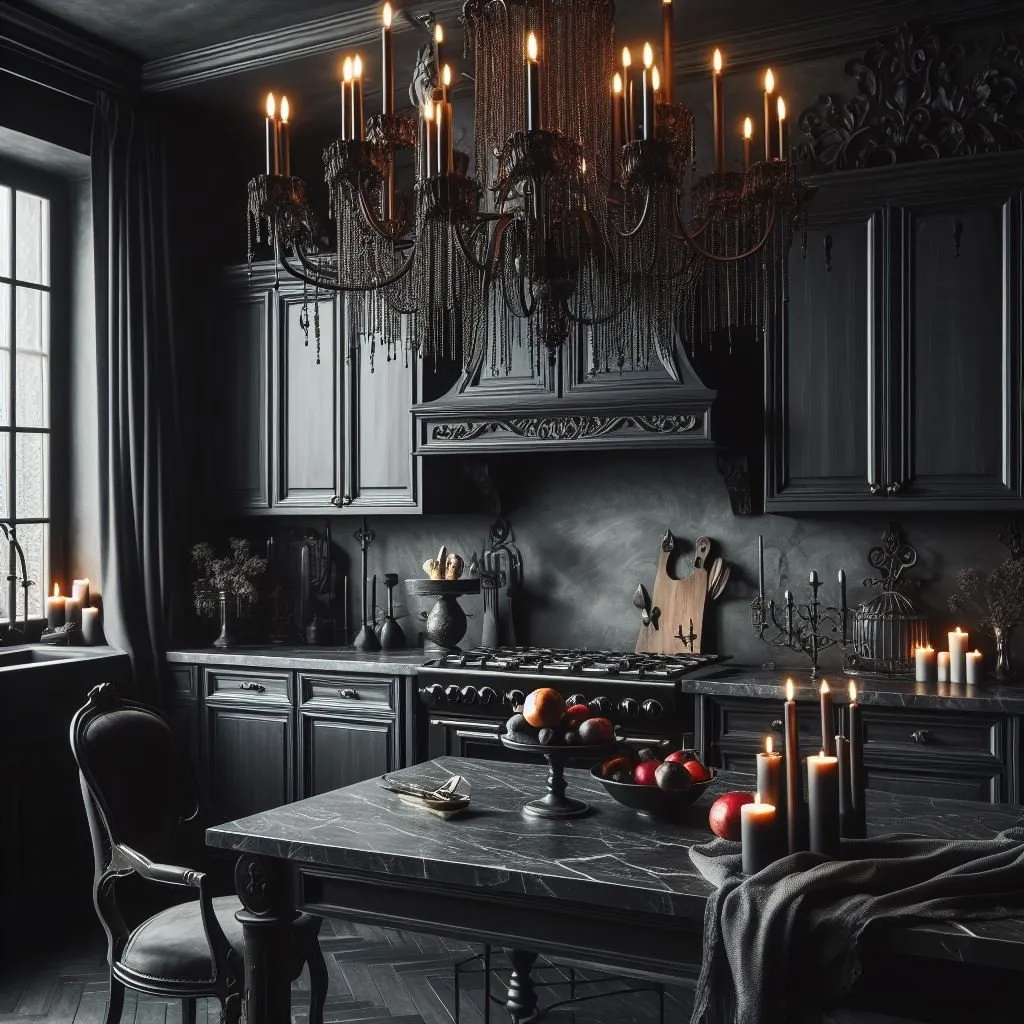Embracing Gothic Kitchen Decor
Gothic kitchen decor transforms the heart of your home into a space of dramatic elegance and mysterious charm. This style moves away from the usual bright and airy kitchens, embracing a darker, more opulent aesthetic. It’s about creating an atmosphere that is both inviting and intriguing, where deep colors, intricate details, and a touch of the macabre come together. If you’re drawn to the allure of historical design, the gothic style offers a unique way to express your personality and create a truly memorable kitchen. This isn’t just about following trends; it’s about crafting a space that reflects your individual style and appreciation for the extraordinary. By incorporating key elements, you can achieve a stunning gothic kitchen that is both functional and visually captivating. Get ready to explore the bold ideas that will help you bring this captivating style to life!
Dark & Moody Color Palettes
The foundation of a gothic kitchen lies in its rich and evocative color palette. Forget the sterile whites and embrace the depths of charcoal, deep blues, and even blacks. These colors create a sense of intimacy and sophistication. Consider incorporating jewel tones like emerald green and ruby red as accents to add pops of color and enhance the overall drama. The key is to select colors that evoke a sense of mystery and luxury. Dark colors absorb light, creating a cozy and intimate atmosphere. Experiment with various shades to find a combination that resonates with your personal style. Consider using these dark, rich colors not just on walls but also on cabinetry and even appliances to fully embrace the gothic aesthetic. The goal is to create a kitchen that feels less like a functional space and more like a sanctuary.
Deep Wall Colors
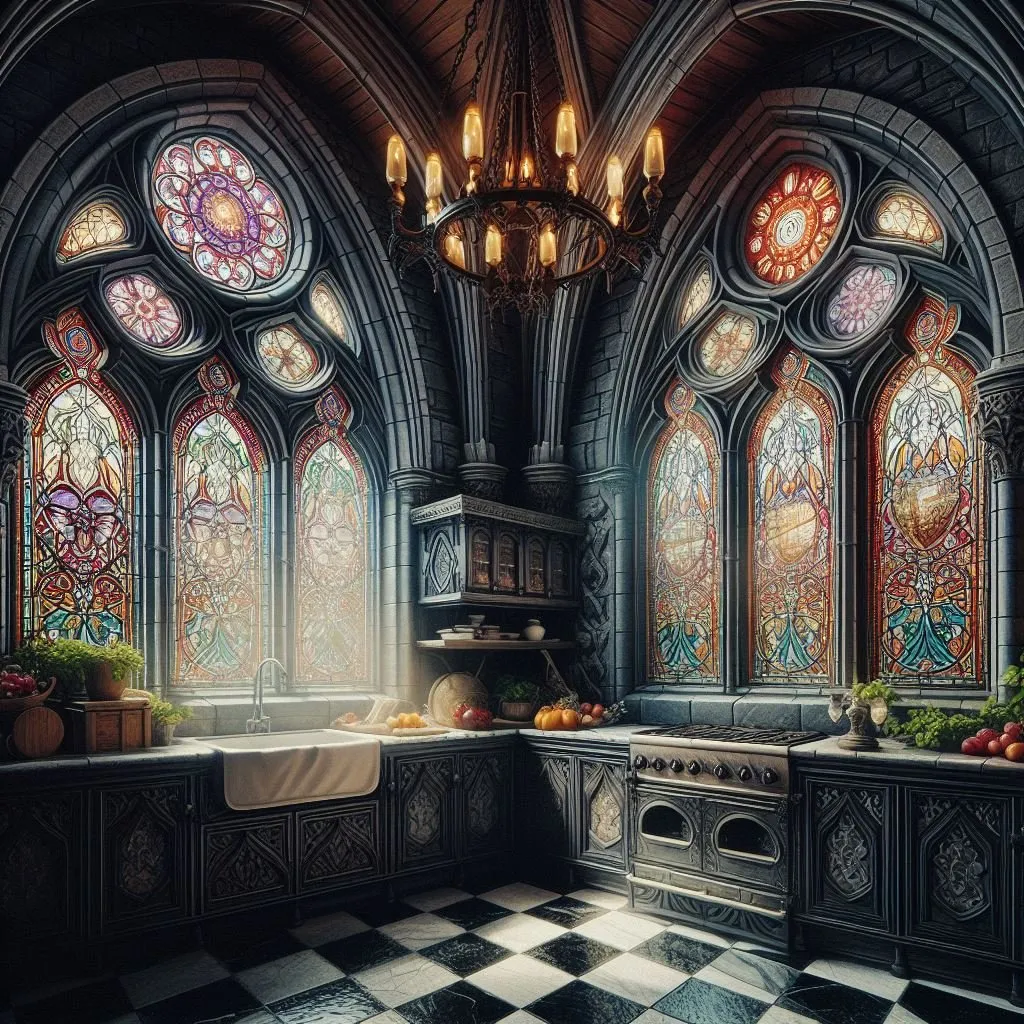
Painting your kitchen walls in deep colors is a transformative step. Consider colors such as charcoal gray, navy blue, or even a deep burgundy. These hues instantly set the gothic tone. Ensure proper lighting to counteract the darkness; strategic placement of light fixtures is critical. Using matte finishes will enhance the depth of the color and minimize reflections, adding to the gothic ambiance. Before committing, test different shades and lighting conditions to ensure the chosen color complements the other elements in your kitchen. The right wall color can set the stage for a truly gothic kitchen that exudes elegance and sophistication. By starting with deep, rich wall colors, you’ll be well on your way to creating a dramatic and captivating space.
Accent Walls
An accent wall provides an excellent opportunity to introduce textures and patterns. Consider using wallpaper with gothic-inspired motifs, such as damask or fleur-de-lis patterns, to create visual interest. Another option is to install a dark-colored tile backsplash with intricate designs. The accent wall can be a focal point that draws the eye and adds a touch of personality to your gothic kitchen. This is where you can get creative with textures. Think about using a textured paint finish or even exposed brick to enhance the gothic aesthetic. The right accent wall can create a focal point that showcases your style and adds a touch of drama to the room. When selecting an accent wall, consider it as an opportunity to express your creativity and make a bold statement.
Statement Cabinetry
Cabinetry plays a pivotal role in gothic kitchen design. Opt for cabinets in dark woods like mahogany or walnut, or consider painting them in deep, rich colors that complement your wall colors. The style of the cabinetry is essential; consider ornate door panels, detailed molding, or even arched designs to capture the gothic aesthetic. It’s important to choose hardware that enhances this theme, such as antique bronze or wrought iron. Your cabinetry should be both functional and a visual statement. The design should be elegant and imposing, reflecting the gothic era’s architectural influences. These cabinets will set the tone for your kitchen, creating an atmosphere of grandeur and sophistication. Think of your cabinetry as a central piece of the gothic puzzle.
Intricate Details & Hardware
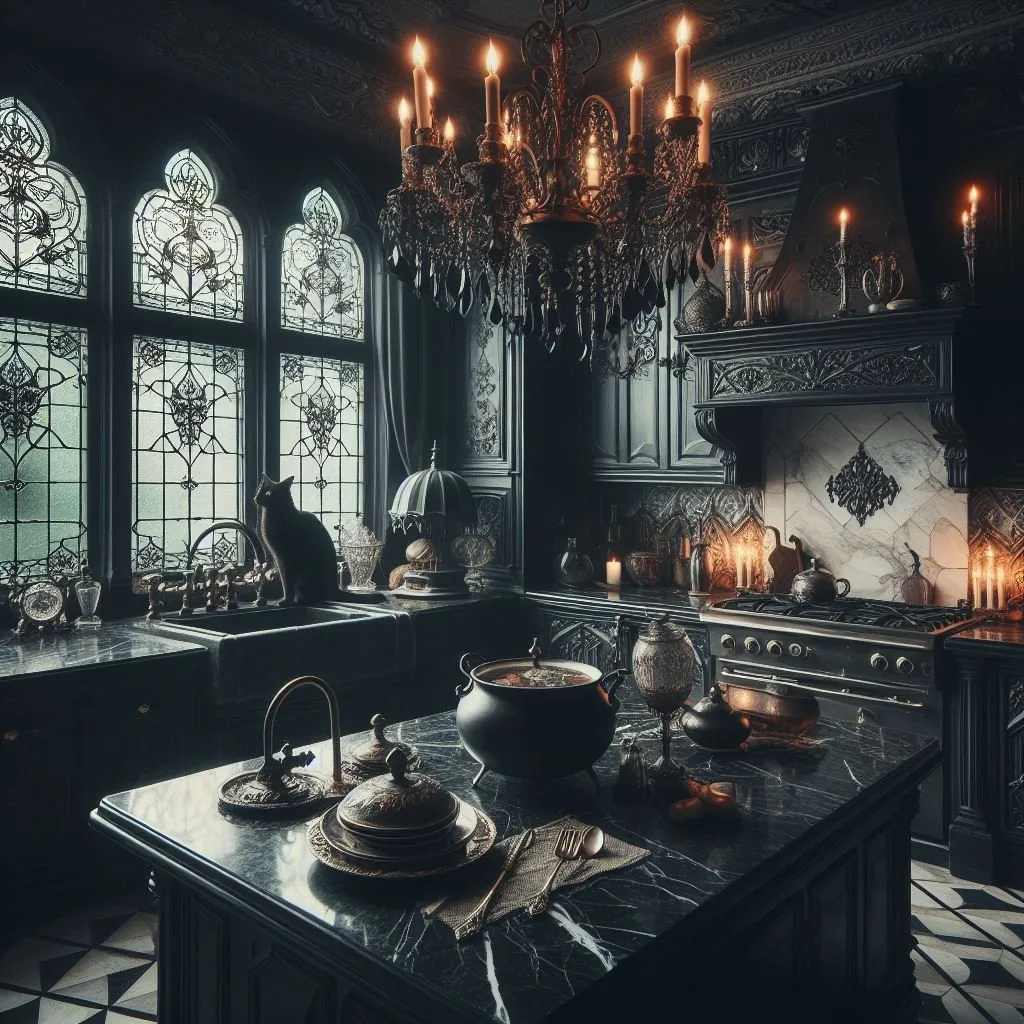
Attention to detail is key in gothic kitchen decor. Select hardware that reflects the gothic style: think ornate knobs and pulls, often made of wrought iron, antique bronze, or even pewter. These small details can make a significant impact on the overall aesthetic. Don’t overlook the finer points like cabinet hinges and drawer pulls – these details contribute to the authentic gothic atmosphere. Consider incorporating intricate carvings or embellishments on your cabinets and furniture. These small elements can add layers of sophistication and enhance the gothic theme. This is where you can really personalize your space and showcase your attention to detail. Ensure that every element is carefully chosen to contribute to the overall gothic feel.
Ornate Cabinet Knobs and Pulls
Choosing the right hardware is a crucial step in achieving a gothic look. Opt for cabinet knobs and pulls with intricate designs, such as fleur-de-lis, gothic arches, or detailed scrollwork. Materials like wrought iron, antique brass, or pewter are excellent choices as they enhance the gothic aesthetic. Consider the finish of your hardware – antique or oil-rubbed finishes add a sense of age and history, which is essential for gothic design. The hardware should not only be functional but also serve as decorative elements that contribute to the overall style. The details on your knobs and pulls should match the intricate details of your cabinetry, making the overall design cohesive and visually appealing. Focus on selecting hardware that reflects your love for historical and architectural detail.
Gothic-Inspired Lighting
Lighting plays a crucial role in setting the mood in a gothic kitchen. Choose fixtures that are both functional and aesthetically aligned with the gothic theme. Chandeliers, sconces, and pendants with dark finishes, ornate detailing, or even candelabra-style designs are excellent choices. Avoid harsh, modern lighting. Instead, aim for softer, warmer light sources to create a more inviting atmosphere. Consider using dimmer switches to adjust the intensity of the light and further enhance the mood. The lighting should complement the other elements in your kitchen, such as the color palette and cabinetry, to create a cohesive and immersive gothic environment. Lighting is more than just functionality; it’s about creating an atmosphere that is both beautiful and mysterious.
Chandeliers and Sconces
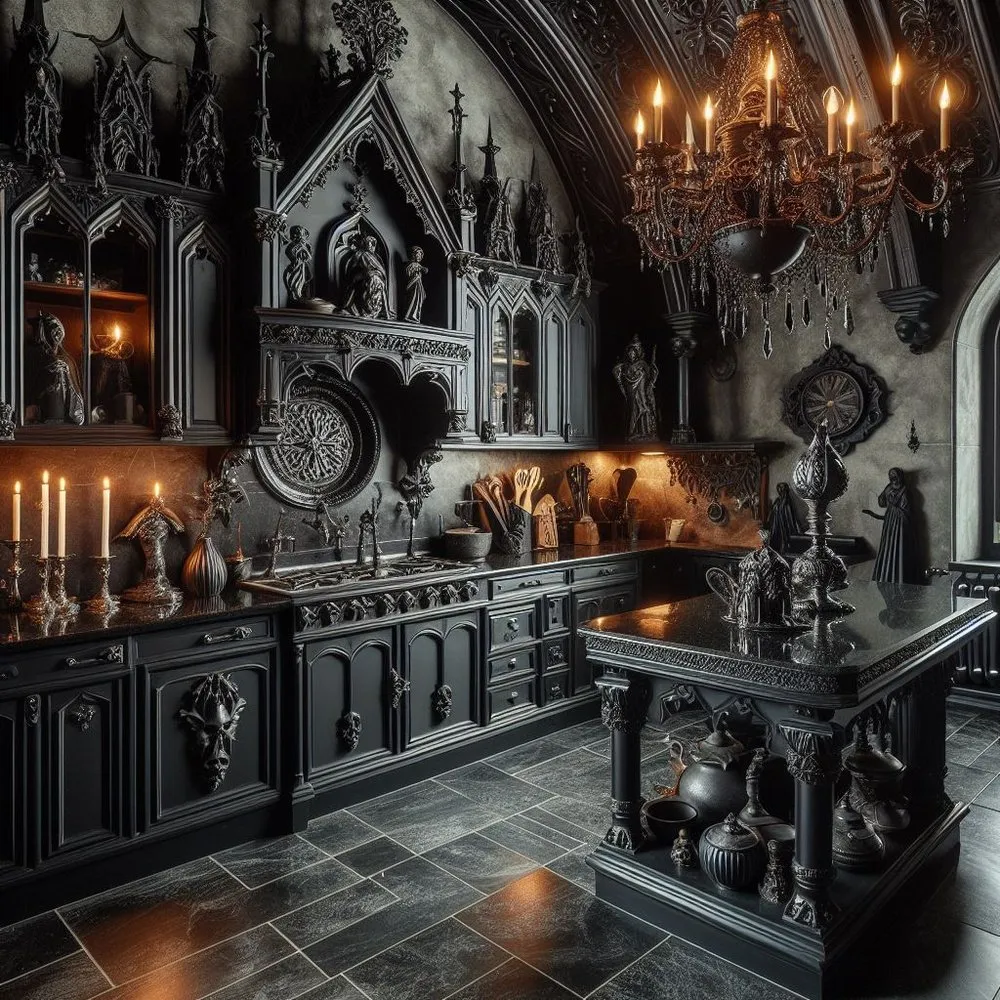
Chandeliers are an essential element for gothic kitchens. Look for chandeliers with dark finishes, such as wrought iron or antique bronze, and intricate designs. Crystal or glass elements can add a touch of sparkle and elegance, but ensure they complement the overall gothic aesthetic. Sconces, particularly those with candle-like designs or dark finishes, can be used to enhance the ambient lighting and add to the gothic atmosphere. The placement of these fixtures is also critical. Position chandeliers over kitchen islands or dining areas to create a focal point, and use sconces along walls to provide soft, atmospheric lighting. Your lighting should be both functional and create a sense of drama, adding to the gothic environment of your kitchen.
Unique Fixtures
Consider unique light fixtures, such as pendant lights with interesting shapes and finishes. Look for fixtures that incorporate gothic design elements, such as pointed arches or ornate details. The choice of light bulbs can also contribute to the gothic aesthetic. Use bulbs that emit warm, soft light to create an inviting atmosphere. Consider using vintage-style Edison bulbs to add a touch of historical charm. Unique fixtures will make a statement in your gothic kitchen and enhance the overall gothic feel. Choose fixtures that complement your color palette and cabinetry design. You want to create a space that is not only well-lit but also reflects your personal style and appreciation for the gothic aesthetic.
Adding Gothic Accessories
Accessorizing your kitchen is key to completing the gothic transformation. Introduce accessories that reflect the gothic style. These elements are the finishing touches that transform your kitchen into a gothic haven. Consider adding items with dark finishes or intricate designs. Think about the purpose of each accessory; it should serve both a practical and decorative role. The right accessories can really enhance the atmosphere. This allows you to add personality and style, creating a cohesive and inviting gothic space. The goal is to create a balance between functionality and aesthetic appeal. Incorporating these accessories will help make your gothic kitchen unique and beautiful.
Candlesticks and Vases
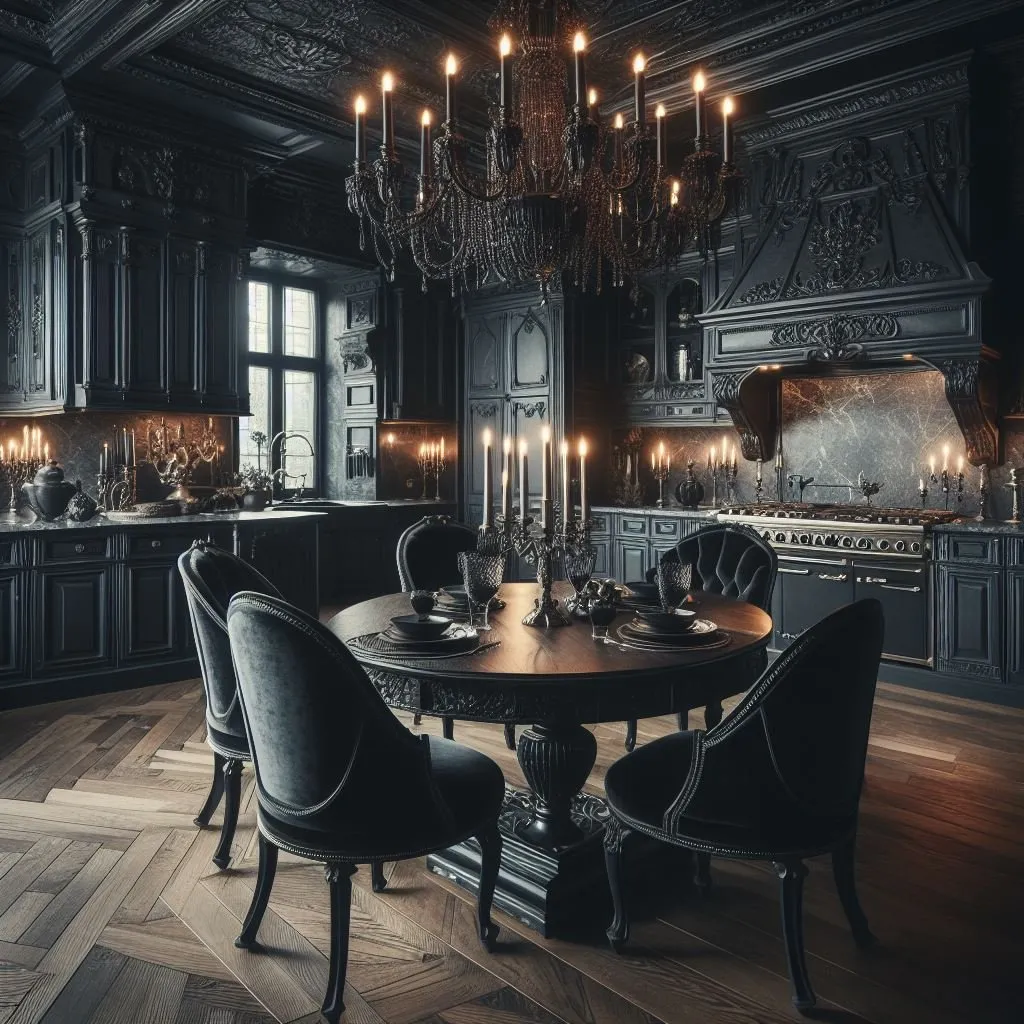
Candlesticks are a staple in gothic decor. Choose candlesticks made of wrought iron, pewter, or antique brass to add a touch of elegance and drama. Vary the heights and styles of your candlesticks to create visual interest. Vases can also be used to enhance the gothic style. Select vases with dark finishes, intricate designs, or unusual shapes. Use them to display flowers, branches, or other decorative elements that fit the gothic theme. These accessories can add a sense of history and create an intimate and inviting space. By placing candlesticks and vases strategically, you can enhance the visual appeal of your gothic kitchen and create a memorable space.
Dark Textiles and Tableware
Textiles and tableware can add layers of richness to your gothic kitchen. Use dark-colored tablecloths, placemats, and napkins to complement the overall color scheme. Consider materials like velvet, brocade, or linen to add texture and sophistication. For tableware, opt for dark-colored dishes, silverware, and glassware. Look for pieces with intricate details or patterns. This will tie the design together. The textiles and tableware you choose can significantly enhance the gothic atmosphere. This will create a cohesive and visually appealing space that embodies the essence of gothic style. These elements are the perfect finishing touches to create a gothic kitchen that is both elegant and inviting.
Creating a Cohesive Gothic Kitchen
Creating a cohesive gothic kitchen is about blending all the elements – color, cabinetry, details, and accessories – to create a unified and visually stunning space. Every aspect of your kitchen should work together to create an immersive gothic experience. The key is to strike a balance between darkness and light, functionality and aesthetics. Ensure that your choices reflect your personal style and appreciation for the gothic aesthetic. Maintain a consistent theme throughout the space. Ensure every element complements the others. The result should be a kitchen that feels harmonious, inviting, and truly gothic. By taking these elements into account, you can design a kitchen that is both beautiful and functional. It’s all about making the space feel like a reflection of your personality and aesthetic preferences.
